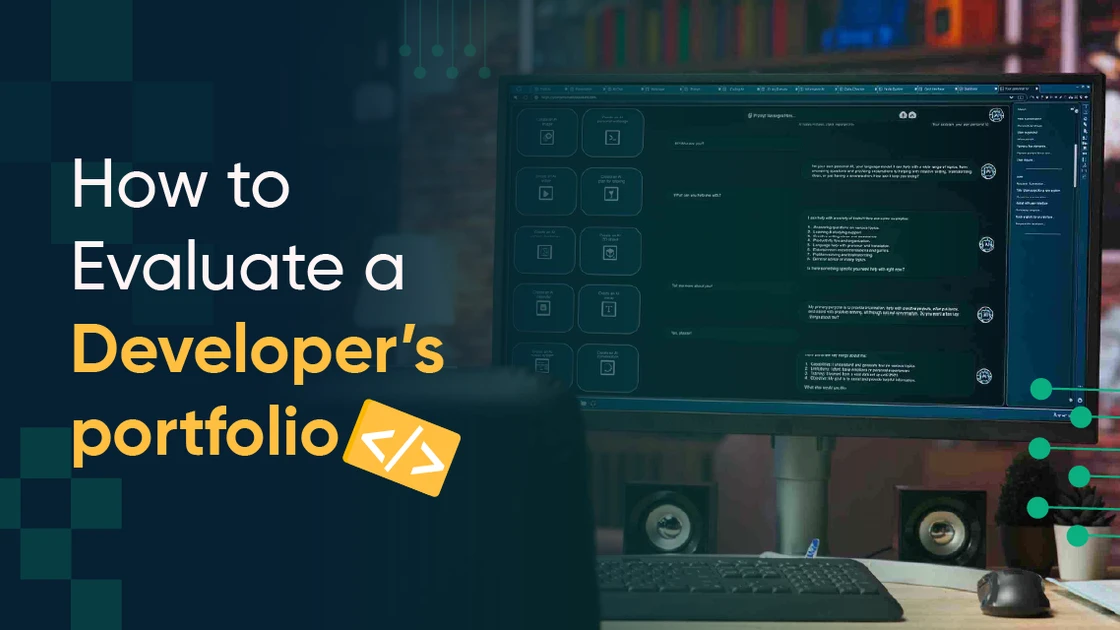Hiring the right developer can shape the success of your digital products. As a business leader, you want to be confident that the person you bring on board has the right skills, mindset and experience.
One of the most effective ways to judge this is by reviewing their portfolio. But the question is: how to evaluate a developer’s portfolio effectively? Whether you are hiring directly or planning to bring in talent through IT staff augmentation, this blog breaks down detailed steps to help you assess a developer’s portfolio with clarity and make better hiring decisions.
How to Evaluate a Developer’s Portfolio: 10 Key Areas to Focus On
When reviewing a developer’s portfolio, it’s not enough to simply glance at the design or the number of projects. A closer look at specific aspects can help you understand their technical ability, creativity, problem-solving mindset, and overall professionalism. Below are 10 essential areas every CXO should examine when evaluating a developer’s portfolio:
1. Review Technical Skills in Depth
Investigate how technologies were applied to solve real-world problems. Assess expertise by reviewing the complexity of features, the quality of code structure and the developer’s ability to optimize solutions, rather than merely listing technologies.
Tip: Explore GitHub repositories or code samples to see clarity, to best software development practices and efficient use of frameworks.
2. Evaluate Performance
Examine how projects perform in real-world conditions. Focus on loading speed, error handling, security standards and smooth navigation. Functionality reflects the developer’s ability to deliver robust, scalable solutions.
Tip: Interact with live project features, test responsiveness across devices and monitor performance under different scenarios.
Look at API integration, database management and system efficiency to ensure the project runs reliably.
3. See If Experience Fits Your Industry
Evaluate whether the developer’s experience aligns with your business sector. Even if they lack direct industry experience such as secure payment integration, API handling or designing scalable architectures can prove invaluable.
Tip: Review projects similar in function or complexity to your requirements and observe how the developer approached industry-specific challenges.
Pay attention to regulatory compliance, industry-specific workflows and any custom solutions that demonstrate adaptability and strategic thinking.
4. Look at Variety of Projects
Assess the variety of projects included, from personal endeavors to freelance and collaborative work. Diversity reflects adaptability and the capacity to tackle different challenges successfully.
Tip: Observe the types of applications, platforms or roles the developer has undertaken and note how they adjusted to different environments.
Pay attention to their ability to manage multiple responsibilities, adapt to various project scopes and work in different team settings.
5. Creative Problem-Solving and Innovation
Focus on how the developer approaches challenges with creative solutions, separate from pure technical implementation. This shows their ability to think critically and design unique approaches.
Tip: Look for case studies or project descriptions detailing challenges and innovative solutions.
Highlight efficiency improvements, unique features or novel approaches that differentiate their work.
6. Evaluate Documentation Clarity
Assess the clarity and structure of technical documentation. Unlike teamwork, this emphasizes the developer’s ability to explain complex systems clearly and maintain knowledge sharing.
Tip: Review README files, inline comments and guides for thoroughness and readability.
Good documentation demonstrates attention to detail, forward-thinking and the capacity to support long-term maintainability.
7. Measure Client or User Impact
Assess measurable results, such as improved application performance, increased user engagement or higher conversion rates. Impact reveals the developer’s tangible contribution to business success.
Tip: Examine metrics, analytics reports or client testimonials to determine project effectiveness.
Consider how the developer’s work influenced overall project outcomes, enhanced user experience and contributed to client satisfaction.
8. Continuous Learning and Latest Tools
Verify whether the developer adopts modern frameworks, contributes to open-source projects or engages in ongoing learning. Staying current ensures their skills remain relevant in an ever-evolving technological landscape.
Tip: Check their use of contemporary frameworks, involvement in developer communities or completion of recent certifications.
Continuous learning reflects adaptability, curiosity and a commitment to improving technical proficiency and staying ahead of trends.
9. Teamwork and Collaborative Skills
Evaluate the developer’s ability to work effectively with others. This includes communication, active participation in projects and contributing to team success, distinct from technical documentation.
Tip: Look for projects highlighting team roles, joint problem-solving or leadership contributions.
Strong collaboration ensures smooth integration into your organization and enhances overall team performance.
10. Review Presentation and Professionalism
Assess the portfolio’s visual and structural quality. A professional presentation conveys attention to detail and the developer’s commitment to delivering work with clarity and polish.
Tip: Review layout, navigation, updates and user experience to ensure the portfolio communicates work effectively.
A well-presented portfolio demonstrates professionalism and signals the developer’s approach to quality in their work.
Solution: Building a Robust Evaluation Process
Hiring the right developer is never easy. You start by checking portfolios, reviewing past projects, and trying to judge if the person is the right fit. While this step is important, it often takes too much time and slows down your projects.
This is where staff augmentation makes a difference. Instead of spending weeks searching, you can quickly bring in skilled developers for specific projects and scale your team without the weight of long-term hiring commitments.
The process becomes even simpler with Crewmate, which connects you with pre-vetted developers whose skills and experience are already verified, but also gives you detailed portfolios.
On top of that, you get the chance to interview developers directly and onboard them within 48 hours with a 7-day free trial to ensure the fit is right as well as many other benefits of IT staff augmentation.
As a result, projects move forward without delays, deadlines are achieved, and your business benefits from top-quality technical expertise. With staff augmentation through Crewmate, CXOs can stop worrying about hiring and focus on driving growth, knowing their projects are in capable hands.
Conclusion
Evaluating a developer’s portfolio is about seeing beyond the code. It shows you how they think, how they solve problems, and what kind of results they can deliver. When done thoroughly, this review gives CXOs the confidence that the talent they bring in will match both project needs and company goals.
By combining this evaluation with staff augmentation through Crewmate, you not only identify the right skills but also bring them on board quickly. This balance of careful assessment and smart hiring ensures stronger teams, smoother delivery, and faster growth.
Frequently Asked Questions
Q. Why is evaluating a developer’s portfolio important?
Evaluating a portfolio allows you to go beyond a resume and see how skills are applied in practice. It helps you judge if the developer can handle real-world project challenges, problem-solving scenarios and business requirements. Detailed portfolios also highlight creativity, technical depth and the ability to deliver results, factors that directly influence your project’s success.
Q. What’s the difference between a resume and a portfolio?
The main difference between a resume and a portfolio is that, resume is a summary of experience, education and technical skills, while a portfolio is a collection of real projects that showcase how those skills were applied. For example, a resume might say a developer knows React, but a portfolio can show a full React app built with performance optimization, clean code and user-focused design. Portfolios give decision-makers more tangible proof of capability.
Q. Should I prioritize industry-specific portfolios?
Yes, because prior experience in your industry often shortens the learning curve. For example, a developer with healthcare software experience may already understand compliance rules. However, transferable skills also matter, someone from fintech could bring valuable security expertise into an e-commerce project.


